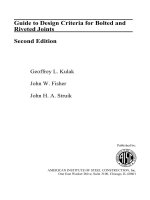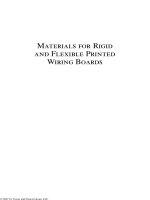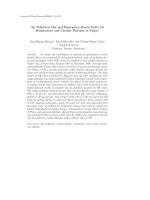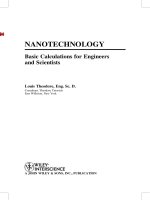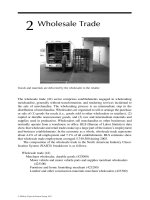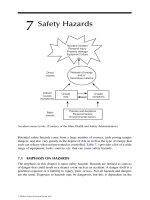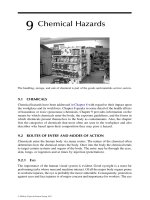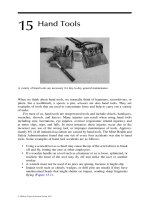Practical Design Calculations for Groundwater and Soil Remediation - Chapter 2 ppt
Bạn đang xem bản rút gọn của tài liệu. Xem và tải ngay bản đầy đủ của tài liệu tại đây (354.63 KB, 53 trang )
Kuo, Jeff "Site characterization and remedial investigation"
Practical Design Calculations for Groundwater and Soil Remediation
Boca Raton: CRC Press LLC,1999
©1999 CRC Press LLC
chapter two
Site characterization and
remedial investigation
II.0 Introduction
The initial step, often the most critical one, of a typical soil and/or ground-
water remediation project is to determine the extent of contamination. It is
often accomplished by site characterization and remedial investigation (RI).
Site characterization is to determine the conditions on and beneath a site
that are pertinent to hazardous waste management. When site remediation
is deemed necessary, RI will be employed. RI activities consist of site char-
acterization and additional data collection. The additional data are necessary
for control of plume migration and selection of remedial alternatives. The
common questions to be answered by the RI activities are, “Where is the
contaminant plume? What is in the plume? How big is the plume? How
long has it been there? Where is it going? How fast will it go?”
Subsurface contamination from spills and leaky underground storage
tanks (USTs) creates environmental problems that usually require corrective
actions. The contaminants may be present in one or a combination of the
following locations and phases:
Vadose zone
• Vapors in the void
• Free product in the void
• Dissolved in soil moisture
• Adsorbed onto the soil matrix
• Floating on top of the capillary fringe (for nonaqueous phase liquids
[NAPLs])
Groundwater
• Dissolved in the groundwater
©1999 CRC Press LLC
• Adsorbed onto the aquifer material
• Sitting on top of the bedrock (for dense nonaqueous phase liquids
[DNAPLs])
Common RI activities include:
1. Removal of contamination source(s) such as leaky USTs
2. Installation of soil borings
3. Installation of groundwater monitoring wells
4. Soil sample collection and analysis
5. Groundwater sample collection and analysis
6. Aquifer testing
Through these activities, the following data are collected:
1. Types of contaminants present in soil and groundwater
2. Concentrations of contaminants in the collected samples
3. Vertical and areal extents of contaminant plumes in soil and ground-
water
4. Vertical and areal extents of free-floating product or the DNAPLs
5. Soil characteristics including the types of soil, density, moisture con-
tent, etc.
6. Groundwater elevations
7. Drawdown data collected from aquifer tests
Using these collected data, engineering calculations are then performed
to assist site remediation. Common engineering calculations include:
1. Mass and volume of soil excavated during tank removal
2. Mass and volume of contaminated soil left in the vadose zone
3. Mass of contaminants in the vadose zone
4. Mass and volume of the free-floating product
5. Volume of contaminated groundwater
6. Mass of contaminants in the aquifer
7. Groundwater flow gradient and direction
8. Hydraulic conductivity of the aquifer
This chapter describes all the above-needed engineering calculations,
except the last two, which will be covered in Chapter 3. Discussions will
also be presented concerning the calculations related to site activities, includ-
ing cuttings from soil boring and purge water from groundwater sampling.
The last part of the chapter describes the “partitioning” of contaminants in
different phases. Understanding the partitioning phenomena of the contam-
inants is critical for studying the fate and transport of contaminants in the
subsurface and for selection of remedial alternatives.
©1999 CRC Press LLC
II.1 Determination of the extent of contamination
II.1.1 Mass and concentration relationship
As mentioned earlier, contaminants may exist in different phases. In envi-
ronmental engineering applications, people commonly express contaminant
concentrations in parts per million (ppm), parts per billion (ppb), or parts
per trillion (ppt).
Although these concentration units are commonly used, some people
may not realize that “one ppm,” for example, does not mean the same for
liquid, solid, and air phases. In the liquid and solid phases, the ppm unit is
on a mass per mass basis. One ppm stands for one part mass of a compound
in one million parts mass of the media containing it. Soil contaminated with
one ppm benzene means that every gram of soil contains one microgram of
benzene, i.e., 10
–6
g benzene per gram of soil, or 1 mg benzene per kilogram
of soil (1 mg/kg).
For the liquid phase, one ppm of benzene means 1
µ
g of benzene dis-
solved in 1 g of water, or 1 mg benzene per kilogram water. Since it is usually
more convenient to measure the liquid volume than its mass, and 1 kg of
water has a volume of approximately 1 L under ambient conditions, people
commonly use “1 ppm” for “1 mg/L compound concentration in liquid.”
For the vapor phase, the story is totally different. One ppm by volume
(ppmV) is on a volume per volume basis. One ppmV of benzene in the air
means one part volume of benzene in one million parts volume of air space.
To convert the ppmV into mass concentration units, which is often needed
in remediation work, we can use the following formula:
[Eq. II.1.1]
or
[Eq.II.1.2]
1
22 4
24 05
24 5
.
.
.
ppmV [mg/m ] at 0 C
[mg/m ] at 20 C
[mg/m ] at 25 C
3
3
3
=°
=°
=°
MW
MW
MW
1
359
385
392
ppmV 10 [lb/ft ] at 32 F
10 [lb/ft ] at 68 F
10 [lb/ft ] at 77 F
63
63
63
=× °
=× °
=× °
−
−
−
MW
MW
MW
©1999 CRC Press LLC
where MW is the molecular weight of the compound, and the number in
the denominator of each equation above is the molar volume of an ideal gas
at that temperature. For example, the volume of an ideal gas is 22.4 L per
gram-mole at 0°C, or 359 ft
3
per pound-mole at 32°F.
Let us determine the conversion factors between ppmV and mg/m
3
or
lb/ft
3
, using benzene (C
6
H
6
) as an example. The molecular weight of benzene
is 78, therefore 1 ppmV of benzene is the same as
[Eq. II.1.3]
From this practice, we learn that the conversion factors are different
among compounds because of the differences in molecular weight. In addi-
tion, the conversion factor for a compound is temperature dependent
because its molar volume varies with temperature.
In remediation design, it is often necessary to determine the mass of a
contaminant present in a medium. It can be found from the contaminant
concentration and the amount of the medium containing the contaminant.
The procedure for such calculations is simple but slightly different for the
liquid, soil, and air phases. The differences mainly come from the concen-
tration units.
Let us start with the simplest case that a liquid is polluted with a dis-
solved contaminant. Dissolved contaminant concentration in the liquid (
C
)
is often expressed in mass of contaminant/volume of liquid, such as milli-
grams per liter, therefore, mass of the contaminant in the liquid can be
obtained by multiplying the concentration by the volume of liquid (
V
l
):
[Eq. II.1.4]
Contaminant concentration on a soil surface (
X
) is often expressed in
mass of contaminant/mass of soil, such as milligrams per kilogram; there-
fore, the mass of contaminants can be obtained by multiplying the concen-
tration with the mass of soil (
M
s
). Mass of soil, in turn, is the multiplication
product of volume of soil (
V
s
) and bulk density of soil (
ρ
b
):
[Eq. II.1.5]
1 ppmV benzene
78
24.05
3.24 mg/m at 20 C
78
24.5
3.18 mg/m at 25 C
78
392
= 0.199 10 lb/ft at 77 F (25 C)
3
3
63
== °
== °
=× × °°
−−
10
6
Mass of contaminant in liquid =
(liquid volume)(liquid concentration) = (V )(C)
l
Mass of contaminant in soil = ( )( )
( )[( )( )]
XM
XV
S
S
=ρ
b
©1999 CRC Press LLC
Contaminant concentration in air (
G
) is often expressed in vol/vol such
as ppmV or in mass/vol such as mg/m
3
. In calculation of mass, we need to
convert the concentration into the mass/vol basis first using Eq. II.1.2. Mass
of the contaminant in air can then be obtained by multiplying the concen-
tration with the volume of air (
V
a
):
[Eq. II.1.6]
Example II.1.1A Mass and concentration relationship
Which of the following media contains the largest amount of xylene?
a. 1 million gallons of water containing 10 ppm of xylene
b. 100 cubic yards of soil (bulk density = 1.8 g/cm
3
) with 10 ppm of
xylene
c. An empty warehouse (200’
×
50’
×
20’) with 10 ppmV xylene in air
Solution:
a. Mass of contaminant in liquid = (liquid volume)(liquid concentration)
= (1,000,000 gallon)(3.785 L/gallon)(10 mg/L) = 3.79
×
10
7
mg
b. Mass of contaminant in soil = (soil volume)(density)(soil concentra-
tion)
= [(100 yd
3
)(27 ft
3
/yd
3
)(30.48 cm/ft)
3
]
[(1.8 g/cm
3
(kg/1000g)](10 mg/kg)
= 1.37
×
10
6
mg
c. Molecular weight of xylene [C
6
H
4
(CH
3
)
2
]
= (12)(6) +(1)(4) + (12 + 1
×
3)(2) = 106 g/mole
10 ppmV = (10)(MW of xylene/24.05) mg/m
3
= (10)(106/24.05) mg/m
3
= 44.07 mg/m
3
Mass of contaminant in air = (air volume)(vapor concentration)
= [(200
×
50
×
20 ft
3
)(0.3048 m/ft)
3
](44.07 mg/m
3
)
= 2.5
×
10
5
mg
The water contains the largest amount of xylene.
Mass of contaminant in air =
(air volume)(concentration in mass/vol) = ( )( )VG
a
©1999 CRC Press LLC
Example II.1.1B Mass and concentration relationship
If a person drinks 2 L of water containing 1 ppb of benzene and inhales
20 m
3
of air containing 10 ppbV of benzene a day, which system (ingestion
or inhalation) is exposed to more benzene?
Solution:
a. Benzene ingested daily:
(2 L)(10
–3
mg/L) = 2
×
10
–3
mg
b. Molecular weight of benzene (C
6
H
6
) = (12)(6) +(1)(6) = 78 g/mole
10 ppbV = (10
×
10
–3
)(78/24.05) mg/m
3
= 0.0324
mg/m
3
Benzene inhaled daily:
(20 m
3
)(0.0324 mg/m
3
) = 0.65
mg
The inhalation system is exposed to more benzene.
Example II.1.1C Mass and concentration relationship
A glass bottle containing 900 mL of methylene chloride (CH
2
Cl
2
, specific
gravity = 1.335) was accidentally left uncapped over a weekend in a poorly
ventilated room (5 m
×
6 m
×
3.6 m). On the following Monday it was found
that two thirds of methylene chloride had volatilized. For a worst-case sce-
nario, would the concentration in the room air exceed the permissible expo-
sure limit (PEL) of 100 ppmV?
Solution:
a. Mass of methylene chloride volatilized = (liquid volume)(density)
[(2/3)(900 mL)(1 mL/cm
3
)](1.335 g/cm
3
) = 801 g = 8.01
×
10
5
mg
b. Vapor concentration in mass/vol = (mass) ÷ (volume)
(8.01
×
10
5
mg) ÷ [(5 m)(6 m)(3.6 m)] = 7417 mg/m
3
c. Molecular weight of methylene chloride [CH
2
Cl
2
] = (12) + (1)(2) +
(35.5)(2) = 85 g/mole
1 ppmV = (85/24.05) mg/m
3
= 3.53
mg/m
3
©1999 CRC Press LLC
Vapor concentration in vol/vol = 7417 mg/m
3
÷ [3.53 (mg/m
3
)/ppmV]
= 2100 ppmV
It would exceed the PEL.
Example II.1.1D Mass and concentration relationship
A child went into a site and played with dirt contaminated with benzene.
During his stay at the site he inhaled 2 m
3
of air containing 10 ppbV of
benzene and ingested a mouthful (~5 cm
3
) of soil containing 3 mg/kg
of
benzene. Which system (ingestion or inhalation) is exposed to more benzene?
Assume the bulk density of soil is 1.8 g/cm
3
.
Solution:
a. 10 ppbV of benzene = (10
×
10
–3
)(78/24.05) mg/m
3
= 0.0324
mg/m
3
Mass of benzene inhaled = (air volume)(vapor concentration)
= (2 m
3
)(0.0324 mg/m
3
) = 0.065
mg
b. Benzene ingested = (volume of soil)(density of soil)(soil concentration)
[(5 cm
3
)(1.8 g/cm
3
)(1 kg/1000 g)](3 mg/kg) = 0.027 mg
The inhalation system is exposed to more benzene.
II.1.2 Amount of soil from tank removal or excavation of
contaminated area
Removal of USTs typically involves soil excavation. If the excavated soil is
clean (i.e., free of contaminants or below the permissible levels), it may be
reused as backfill materials or disposed of in a sanitary landfill. On the other
hand, if it is contaminated, it needs to be treated or disposed of in a hazard-
ous waste landfill. For either case, a good estimate of soil volume and/or
mass is necessary.
The excavated soil is usually stored on site first as stockpiles. The amount
of excavated soil from tank removal can be determined from measurement
of the volumes of the stockpiles. However, the shapes of these piles are
irregular, and this makes the measurement more difficult. An easier and
more accurate alternative is
Step 1: Measure the dimensions of the tank pit.
Step 2: Calculate the volume of the tank pit from the measured dimen-
sions.
©1999 CRC Press LLC
Step 3: Determine the number and volumes of the USTs removed.
Step 4: Subtract the total volume of the USTs from the volume of the
tank pit.
Step 5: Multiply the value from Step 4 with a soil fluffy factor.
Information needed for this calculation
• Dimensions of the tank pit (from field measurement)
• Number and volumes of the USTs removed (from drawings or field
measurement)
• Density of soil (from measurement or estimate)
• Soil fluffy factor (from estimate)
Example II.1.2A Determine the mass and volume of soil excavated
from a tank pit
Two 5000-gal USTs and one 4000-gal UST were removed. The excavation
resulted in a tank pit of 50’
×
24’
×
18’. The excavated soil was stockpiled
on-site. The bulk density of soil in situ (before excavation) is 1.8 g/cm
3
, and
bulk density of soil in the stockpiles is 1.64 g/cm
3
. Estimate the mass and
volume of the excavated soil.
Solution:
Volume of the tank pit = (50’)(24’)(18’) = 21,600 ft
3
Total volume of the USTs = (2)(5000) + (1)(4000) = 14,000 gallons
= (14,000 gallon)(ft
3
/7.48 gallon) = 1872 ft
3
Volume of soil in the tank pit before removal = (volume of tank pit) –
(volume of USTs)
= 21,600 – 1972 = 19,728 ft
3
Volume of soil excavated (in the stockpile) = (volume of soil in the tank
pit)
×
(fluffy factor)
= (19,728)(1.10) = 21,700 ft
3
= (21,700 ft
3
)[yd
3
/27 ft
3
] = 804 yd
3
Mass of soil excavated = (volume of the soil in the tank pit)(bulk density
of soil in situ) = (volume of the soil in the stockpile)(bulk density of
soil in the stockpile)
Soil density in situ = 1.8 g/cm
3
= (1.8 g/cm
3
)[(62.4 lb/ft
3
)/(1g/cm
3
)]
= 112 lb/ft
3
©1999 CRC Press LLC
Soil density in stockpiles = (1.64)(62.4) = 102 lb/ft
3
Mass of soil excavated = (19,728 ft
3
)(112 lb/ft
3
) = 2,210,000 lb = 1100 tons
or = (21,700 ft
3
)(102 lb/ft
3
) = 2,210,000 lb = 1100 tons
Discussion.
The fluffy factor of 1.10 is to take into account the expan-
sion of soil after being excavated from subsurface. The in situ soil is usually
more compacted. A fluffy factor of 1.10 means the volume of soil increases
by 10% from in situ to above ground. On the other hand, the bulk density
of soil in the stockpiles would be lower than that of in situ soil as the result
of expansion after excavation.
Example II.1.2B Mass and concentration relationship of
excavated soil
A leaky 4.5-m
3
underground storage tank was removed. The excavation
resulted in a tank pit of 4 m
×
4 m
×
5 m (L
× W × H), and the excavated
soil was stockpiled on site. Three samples were taken from the pile and the
TPH concentrations were determined to be <100, 1500, and 2000 ppm. What
is the amount of TPH in the pile? Express your answers in both kilograms
and liters.
Solution:
Volume of the tank pit = (4)(4)(5) = 80 m
3
Volume of soil in the tank pit before removal = (volume of tank pit) –
(volume of USTs)
= 80 – 4.5 = 75.5 m
3
Average TPH concentration = (100 + 1500 + 2000)/3
= 1200 ppm = 1200 mg/kg
Mass of TPH in soil = [(75.5 m
3
)(1800 kg/m
3
)](1200 mg/kg)
= 1.63 × 10
8
mg = 163 kg
Volume of TPH in soil = (mass of TPH)/(density of TPH)
= (163 kg)/(0.8 kg/L) = 203.8 L = 53.9 gallons
©1999 CRC Press LLC
Discussion
1. The bulk density of soil was assumed to be 1800 kg/m
3
(i.e., 1.8
g/cm
3
), and the density of total petroleum hydrocarbon (TPH) was
assumed to be 0.8 kg/L (i.e., 0.8 g/cm
3
).
2. The TPH concentration for one of the three samples is below the
detection limit (<100 ppm). Four methods are common for dealing
with values below the detection limit: (1) use the detection limit as
the value, (2) use half of the detection limit, (3) use zero, and (4) select
a value based on a statistical approach (especially when multiple
samples are taken and a few of them are below the detection limit).
In this solution, a conservative approach was taken by using the
detection limit as the concentration.
Example II.1.2C Mass and concentration relationship of
excavated soil
A leaky 1000-gal underground storage tank was removed. The excavation
resulted in a tank pit of 12’ × 12’ × 15’ (L × W × H), and the excavated soil
was stockpiled on site. Five samples were taken from the pile and analyzed
for TPH using EPA method 8015. Based on the laboratory results, an engineer
at CSUF Consulting Company estimated that there were approximately 50
gal of gasoline present in the soil pile. One of the five TPH values in the
report was illegible, and the others were <100, 1000, 2000, and 3000 ppm,
respectively. What is the missing value?
Solution:
Average TPH concentration = (x +100 +1000 + 2000 + 3000)/5
Mass of contaminated soil = [(12)(12)(15) – (1000/7.48)](112)
= 227,000 lb = 103,000 kg
Mass of TPH in soil = (volume of gasoline)(density of gasoline)
= [(50 gal)(ft
3
/7.48 gal)](50 lb/ft
3
)(kg/2.2 lb) = 151.9 kg
= (contaminant concentration)
(mass of contaminated soil)
= [(x + 100 + 1000 + 2000 + 3000)/5 mg/kg]
(103,000 kg)(kg/10
6
mg)
x = the unknown TPH concentration = 1264 ppm
©1999 CRC Press LLC
II.1.3 Amount of contaminated soil in the vadose zone
Chemicals that leak from USTs might move beyond the tank pit. If subsurface
contamination is suspected, soil borings are often drilled to assess the extent
of contamination in the vadose zone. Soil boring samples are then taken at
a fixed interval, e.g., every 5 or 10 ft, and analyzed for soil properties. Selected
samples are submitted to laboratories and analyzed for contaminant concen-
trations. From these data, a contaminant fence diagram is often developed
to delineate the extent of the contaminant plume.
When selecting remedial alternatives, an engineer needs to know the
location of the plume, types of subsurface soil, types of contaminants, mass
and/or volume of the contaminated soil, and mass of contaminants. If the
location of the plume is shallow (not deep from the ground level surface)
and the amount of contaminated soil is not extensive, excavation coupled
with above-ground treatment may be a viable option. On the other hand, in
situ remediation alternatives such as soil venting would be more favorable
if the volume of the contaminated soil is large and deep. Therefore, a good
estimate of the amount of contaminated soil left in the vadose zone is impor-
tant for remediation design. This section describes the methodology for such
calculations.
As mentioned, a fence diagram is often drawn to illustrate the vertical
and areal extents of the plume. Based on the information from the diagram,
the following procedure can be used to determine the amount of contami-
nated soil in the vadose zone:
Step 1: Determine the area of contaminated plume at each sampling
depth, A
i
.
Step 2: Determine the thickness interval for each area calculated above,
h
i.
Step 3: Determine the volume of the contaminated soil, V
s
, using the
following formula:
[Eq. II.1.7]
Step 4: Determine the mass of the contaminated soil, M
s
, by multiplying
V
s
by the density of soil, ρ
b
, as
[Eq. II.1.8]
Information needed for this calculation
• The areal and vertical extent of the plume, A
i
and h
i
• Bulk density of soil, ρ
b
VAh
Sii
i
=
∑
MV
S
b
S
=×ρ
©1999 CRC Press LLC
To determine the mass and volume of contaminated water contained in
a groundwater plume, the following procedure should be followed:
Step 1: Use Eq. II.1.7 to determine the size of the plume.
Step 2: Multiply the volume from Step 1 by aquifer porosity to obtain
the volume of groundwater.
Step 3: Multiply the volume from Step 2 by water density to obtain the
mass of contaminated water.
Example II.1.3A Determine the amount of contaminated soil in
the vadose zone
For the project described in Example II.1.2A, after the USTs were removed,
five soil borings were installed. Soil samples were taken every 5 ft below
ground surface (bgs). Based on the laboratory analytical results and subsur-
face geology, the area of the plume at each soil sampling interval was deter-
mined as follows:
Determine the volume and mass of contaminated soil left in the vadose
zone.
Strategy. The soil samples were taken and analyzed every 5 ft; there-
fore, each plume area represents the same depth interval. The sample taken
at 20-ft depth represents the 5-ft interval from 17.5 to 22.5 ft (the midpoint
of the first two consecutive intervals to the midpoint of the next two con-
secutive intervals), the sample at 25-ft depth represents the 5-ft interval from
22.5 ft to 27.5 ft, and so on.
Solution:
Thickness interval for each area is the same at 5 ft
Volume of the contaminated soil (using Eq. II.1.7)
= (5)(350) + (5)(420) + (5)(560) + (5)(810) = 10,700 ft
3
= 396 yd
3
or (22.5 – 17.5)(350) + (27.5 – 22.5)(420) + (32.5 – 27.5)(560)
+ (37.5 – 32.5)(810) = 10,700 ft
3
Depth (ft bgs) Area of the plume (ft
2
)
15 0
20 350
25 420
30 560
35 810
40 0
©1999 CRC Press LLC
Mass of the contaminated soil (using Eq. II.1.8)
= (10,700 ft
3
)(112 lb/ft
3
) =1,198,400 lb = 599 tons
Example II.1.3B Determine the amount of contaminated soil in
the vadose zone
For the project described in Example II.1.2A, after the USTs were removed,
five soil borings were installed. Soil samples were taken every 5 ft bgs.
However, not all the samples were analyzed because of budget constraints.
Based on the laboratory analytical results and subsurface geology, the area
of the plume at a few depths were determined as follows:
Determine the volume and mass of the contaminated soil left in the
vadose zone.
Strategy. The depth intervals given are not the same as before; there-
fore, each plume area represents a different depth interval. For example, the
sample taken at 25-ft depth represents a 7.5-ft interval, from 22.5 ft to 30 ft.
Solution:
Volume of the contaminated soil (using Eq. II.1.7)
= (5)(350) + (7.5)(420) + (7.5)(810) = 10,915 ft
3
= 406 yd
3
or = (22.5 – 17.5)(350) + (30 – 22.5)(420) + (37.5 – 30)(810)
= 10,915 ft
3
Mass of the contaminated soil (using Eq. II.1.8)
= (10,975 ft
3
)(112 lb/ft
3
) =1,229,200 lb = 615 tons
II.1.4 Mass fraction and mole fraction of components
in gasoline
Gasoline is a common contaminant found in the subsurface as a result of
leaky USTs. Gasoline itself is a mixture of various hydrocarbons, and it may
Depth (ft bgs) Area of the plume (ft
2
)
15 0
20 350
25 420
35 810
40 0
contain more than 200 different compounds. Some of them are lighter and
more volatile than the others (lighter ends vs. heavier ends). Gasoline in soil
samples is usually measured by EPA method 8015 as total petroleum hydro-
carbon (TPH), using gas chromatography (GC). It can also be measured by
EPA method 418.1, using infrared (IR), which is considered more suitable for
heavier-end hydrocarbons. Diesel fuel is often measured by “modified” EPA
method 8015 that takes into account the abundance of heavier ends in diesel
fuel as compared to gasoline. Some of the gasoline constituents are more toxic
than the others. Benzene, toluene, ethylbenzene, and xylenes (BTEX) are gas-
oline constituents of concern because of their toxicity. (Benzene is a known
carcinogen.) BTEX compounds are measured by EPA method 8020. To cut
down the air pollution, many oil companies have developed so-called “new-
formula” gasoline, in which the benzene content is reduced. Some of the
important physical properties of BTEX are tabulated in Table II.1.A.
Sometimes, it is necessary to determine the composition, such as mass
and mole fractions of important compounds, of the gasoline for the following
reasons:
1. Identification of responsible parties. At a busy intersection having two or
more gasoline stations, the free-floating product found beneath a site
may not come from its USTs. Each brand of gasoline usually has its
own distinct formula, mainly due to differences in refining processes
or in the crude oils. Most oil companies have the capabilities to iden-
tify the biomarkers in the gasoline or to determine if the composition
of the free-floating product matches their formula.
2. Determination of health risk. As mentioned, some gasoline constituents
are more toxic than the others, and they should be considered differ-
ently in a risk assessment.
3. Determination of the product age. Some compounds are more volatile
than others. The fraction of volatile constituents in a recently spilled
gasoline should be larger than that in an aged spill.
To determine the mass fractions of compounds in gasoline, the following
procedure can be used:
Table II.1.A Some Physical Properties of BTEX
Formula M.W.
Water
solubility
(mg/L)
Vapor
pressure
(mmHg)
Benzene C
6
H
6
78 1780 @ 25°C 95 @ 25°C
Toluene C
6
H
5
(CH
3
) 92 515 @ 20°C 22 @ 20°C
Ethylbenzene C
6
H
5
(C
2
H
5
) 106 152 @ 20°C 7 @ 20°C
Xylenes C
6
H
4
(CH
3
)
2
106 198 @ 20°C 10 @ 20°C
From
U.S. EPA, CERCLA Site Discharges to POTWs Treatability Manual, EPA
540/2-90-007, Office of Water, U.S. EPA, Washington, DC, 1990.
From LaGrega, M.D. , Buckingham, P.L., and Evans, J.C., Hazardous Waste Man-
agement, McGraw-Hill, New York, 1994. With permission.
©1999 CRC Press LLC
©1999 CRC Press LLC
Step 1: Determine the mass of TPH and mass of each compound of
concern.
Step 2: Determine the mass fraction by dividing the mass of the com-
pound by the mass of TPH.
To determine the mole fractions of compounds in gasoline, the following
procedure can be used:
Step 1: Determine the mass of TPH and mass of each compound of
concern in contaminated soil.
Step 2: Determine the molecular weight of each compound.
Step 3: Determine the molecular weight of gasoline from the composi-
tion and the molecular weights of all constituents. This proce-
dure is tedious, and information may not be readily available.
Assuming the molecular weight of gasoline to be 100, which is
equivalent to that of heptane (C
7
H
16
), is relatively reasonable.
Step 4: Determine the number of moles of each compound by dividing
its mass by its molecular weight.
Step 5: Calculate the mole fraction by dividing the number of moles of
each compound with the number of moles of the TPH.
Information needed for this calculation
• Mass of contaminated soil
• Contaminant concentrations
• Molecular weights of the contaminants
Example II.1.4 Mass and mole fractions of components in
gasoline
Three samples were taken from a soil pile (110 yd
3
) and analyzed for TPH
(EPA method 8015) and for BTEX (EPA method 8020). The average concen-
tration of TPH is 1000 mg/kg, and those of BTEX are 85, 50, 35, and 40
mg/kg, respectively. Determine the mass and mole fractions of BTEX in the
gasoline. The bulk density of the soil is 1.65 g/cm
3
.
Solution:
a. Mass of contaminated soil = (volume of soil)(bulk density)
= [(110 yd
3
)(27 ft
3
/yd
3
)]{(1.65 g/cm
3
)[62.4 lb/ft
3
/(1 g/cm
3
)]}
= 305,800 lb = 139,000 kg
b. Mass of a contaminant in soil = (soil mass)(contaminant concentration)
Mass of TPH = (139,000 kg)(1000 mg/kg) = 1.39 × 10
8
mg = 1.39 × 10
5
g
©1999 CRC Press LLC
Mass of benzene = (139,000 kg)(85 mg/kg) = 1.181 × 10
7
mg
= 1.181 × 10
4
g
Mass of toluene = (139,000 kg)(50 mg/kg) = 6.950 × 10
6
mg
= 6.950 × 10
3
g
Mass of ethylbenzene = (139,000 kg)(35 mg/kg) = 4.865 × 10
6
mg
= 4.865 × 10
3
g
Mass of xylenes = (139,000 kg)(40 mg/kg) = 5.560 × 10
6
mg
= 5.560 × 10
3
g
c. Mass fraction of a compound = (mass of the compound)/(mass of
TPH)
Mass fraction of benzene = (1.181 × 10
4
)/(1.39 × 10
5
) = 0.085
Mass fraction of toluene = (6.95 × 10
3
)/(1.39 × 10
5
) = 0.05
Mass fraction of ethylbenzene = (4.865 × 10
3
)/(1.39 × 10
5
) = 0.035
Mass fraction of xylenes = (5.56 × 10
3
)/(1.39 × 10
5
) = 0.04
d. Moles of a compound = (mass of the compound)/(molecular weight
of the compound)
Moles of TPH = (1.39 × 10
5
)/(100) = 1390 g-mole
Moles of benzene = (1.181 × 10
4
)/(78) = 151.4 g-mole
Moles of toluene = (6.95 × 10
3
)/(92) = 77.5 g-mole
Moles of ethylbenzene = (4.865 × 10
3
)/(106) = 45.9 g-mole
Moles of xylenes = (5.56 × 10
3
)/(106) = 52.5 g-mole
e. Mole fraction of a compound = (moles of the compound)/(moles of
TPH)
Mole fraction of benzene = (151.4)/(1390) = 0.109
Mole fraction of toluene = (77.5)/(1390) = 0.056
Mole fraction of ethylbenzene = (45.9)/(1390) = 0.033
Mole fraction of xylenes = (52.5)/(1390) = 0.038
Discussion. The mass fraction of each compound can also be deter-
mined directly from the ratio of the compound concentration to the TPH
concentration. Using benzene as an example, mass fraction of benzene = (85
mg/kg)/(1000 mg/kg) = 0.085 = 8.5%.
II.1.5 Height of the capillary fringe
The capillary fringe (or capillary zone) is a zone immediately above the water
table of unconfined aquifers. It extends from the top of the water table due
to the capillary rise of water. The capillary fringe often creates complications
©1999 CRC Press LLC
in site remediation projects. In general, the size of the plume in the ground-
water would be much larger than that in the vadose zone because of the
spread of the dissolved plume in the groundwater. If the water table fluctu-
ates, the capillary fringe will move upward or downward with the water
table. Consequently, the capillary fringe above the dissolved groundwater
plume can become contaminated. In addition, if free-floating product exists,
the fluctuation of the water table will cause the free product to move away
vertically and laterally. The site remediation for this scenario will be more
complicated and difficult.
The height of capillary fringe at a site strongly depends on its subsurface
geology. For pure water at 20°C in a clean glass tube, the height of capillary
rise can be approximated by the following equation:
[Eq. II.1.9]
where h
c
is the height of capillary rise in centimeters, and r is the radius of
the capillary tube in centimeters. This formula can be used to estimate the
height of the capillary fringe. As shown in Eq. II.1.9, the thickness of the
capillary fringe will vary inversely with the pore size of a formation. Table
II.1.B summarizes the information from two references with regard to capillary
fringe. As the grain size becomes smaller, the pore radius gets smaller, and
capillary rise increases. The capillary fringe of a clayey aquifer can exceed 10 ft.
Example II.1.5 Thickness of the capillary fringe
A core sample was taken from a contaminated unconfined aquifer and ana-
lyzed for pore size distributions. The effective pore size was determined to
be 5 µm. Estimate the thickness of the capillary fringe of this aquifer.
Table II.1.B Typical Height of Capillary Fringe
Material
Grain size
(mm)
a
Pore radius
(cm)
b
Capillary rise
(cm)
Coarse gravel 0.4 0.38
b
Fine gravel 5–2 2.5
a
Very coarse sand 2–1 6.5
a
Coarse sand 1–0.5 0.05 13.5
a
3.0
b
Medium sand 0.5–0.2 24.6
a
Fine sand 0.2–0.1 0.02 42.8
a
7.7
b
Silt 0.1–0.05 0.001 105.5
a
150
b
Silt 0.05–0.02 200
a
Clay 0.0005 300
b
a
Reid, R. C., Prausnitz, J. M., and Poling, B. F., The Properties of Liquids
and Gases, 4th ed., McGraw-Hill, New York, 1987. With permission.
b
Fetter, C. W., Jr., Applied Hydrogeology, Charles E. Merrill Publishing,
Columbus, OH, 1980. With permission.
h
r
c
=
0 153.
©1999 CRC Press LLC
Solution:
Pore size = 5 × 10
–6
m = 5 × 10
–4
cm.
Using Eq. II.1.9, we obtain capillary rise = (0.153)/(5 × 10
–4
) = 306 cm
= 3.06 m = 10.0 ft
Discussion. The units of h
c
and r in Eq. II.1.9 are in centimeters.
II.1.6 Estimating the mass and volume of the free-floating
product
The product leaked from a UST may accumulate on top of the water table
and form a nonaqueous phase liquid (NAPL) layer. For site remediation it
is often necessary to estimate the volume or mass of this free-floating prod-
uct. The thickness of free product found in the monitoring wells has been
directly used to calculate the volume of the free product. However, these
calculated values are seldom representative of the actual free product volume
existing in the formation.
It is now well known that the thickness of free product found in the
formation (the actual thickness) is much smaller than that floating on top of
the water in a monitoring well (the apparent thickness). Using the apparent
thickness, without any adjustment, to estimate the volume of free product
may lead to an overestimate of the free product volume and overdesign of
the remediation system. The overestimate of free product in the RI phase
may cause difficulties in obtaining approval for final site closure because the
remedial action can never recover the full amount of free product reported
in the site assessment report.
Factors affecting the difference between the actual thickness and the
apparent thickness include the densities (or specific gravity) of the free
product and the groundwater and the characteristics of the formation (espe-
cially the pore sizes). Several approaches have been presented in the litera-
ture to correlate these two thickness. Recently, Ballestero et al.
1
developed
an equation using heterogeneous fluid flow mechanics and hydrostatics to
determine the actual free product thickness in an unconfined aquifer. The
equation is
[Eq. II.1.10]
where t
g
= actual (formation) free product thickness, t = apparent (wellbore)
product thickness, S
g
= specific gravity of free product, and h
a
= distance
from the bottom of the free product to the water table.
If no further data for h
a
are available, average wetting capillary rise can
be used as h
a
. Information on capillary rise can be found in Section II.1.5.
To estimate the actual thickness of free product, the following procedure
can be used:
tt S h
gga
=− −()1
©1999 CRC Press LLC
Step 1: Determine the specific gravity of free product. (The specific grav-
ity of gasoline can be reasonably assumed as 0.75 to 0.85 if no
additional information is available.)
Step 2: Determine the apparent thickness of the free product in the well.
Step 3: Determine the actual thickness of free product in the formation
by inserting values of the above parameters into Eq. II.1.10.
Information needed for this calculation
• Specific gravity (or density) of the free product, S
g
• Measured thickness of free product in the well, t
• Capillary rise, h
c
To determine the mass and volume of the free-floating product the
following procedure can be used:
Step 1: Determine the areal extent of the free-floating product.
Step 2: Determine the true thickness of the free-floating product.
Step 3: Determine the volume of the free-floating product by multiply-
ing the area with the true thickness and the porosity of the
formation.
Step 4: Determine the mass of the free-floating product by multiplying
the volume with its density.
Information needed for this calculation
• Areal extent of the free-floating product
• True thickness of the free-floating product
• Porosity of the formation
• Density (specific gravity) of the free-floating product
Example II.1.6A Determine the true thickness of the free-floating
product
A recent survey of a groundwater monitoring well showed a 75-in thick
layer of gasoline floating on top of the water. The density of gasoline is
0.8 g/cm
3
, and the thickness of the capillary fringe above the water table
is 1 ft. Estimate the actual thickness of the free-floating product in the
formation.
Solution:
Using Eq. II.1.10, we obtain:
Actual free product thickness = (75)(1 – 0.8) – 12 = 3 in
©1999 CRC Press LLC
Discussion. As shown in this example, the actual thickness of the free
product is only 3 in, while the apparent thickness within the monitoring well
is much higher at 75 in.
Example II.1.6B Estimate the mass and volume of the free-floating
product
Recent groundwater monitoring results at a contaminated site indicate the
areal extent of the free-floating product is approximately a rectangular shape
of 50 ft × 40 ft. The true thicknesses of the free-floating product in the four
monitoring wells inside the plume are 2, 2.6, 2.8, and 3 ft, respectively. The
porosity of the subsurface is 0.35. Estimate the mass and volume of the free-
floating product present at the site. Assume the specific gravity of the free-
floating product is 0.8.
Solution:
a. The areal extent of the free-floating product = (50’)(40’) = 2000 ft
2
.
b. The average thickness of the free-floating product
= (2 + 2.6 + 2.8 + 3)/4 = 2.6 ft
c. The volume of the free-floating product = (area)(thickness)(porosity
of the formation)
= (2000 ft
2
)(2.6 ft)(0.35) = 1820 ft
3
= (1820 ft
3
)(7.48 gal/ft
3
) = 13,610 gal
d. Mass of the free-floating product = (volume of the free-floating prod-
uct)(density of the free-floating product)
= (1820 ft
3
){0.8 g/cm
3
)[(62.4 lb/ft
3
)/(1 g/cm
3
)]}
= 90,854 lb = 41,300 kg
II.1.7 Determination of the extent of contamination —
a comprehensive example calculation
This subsection presents a comprehensive example related to the assessment
of a contaminated site starting from tank pull, soil boring, and groundwater
monitoring.
©1999 CRC Press LLC
Example II.1.7 Determination of the extent of contamination
A gasoline station is located in the greater Los Angeles Basin within the floor
plain of the Santa Ana River. The site is underlain primarily with coarser-
grained river deposit alluvium. Three 5000-gal steel tanks were excavated
and removed in May of 1997, with the intention that they would be replaced
with three dual-wall fiberglass tanks within the same excavation.
During the tank removal it was observed that the tank backfill soil
exhibited a strong gasoline odor. Based on visual observations, the fuel
hydrocarbon in the soil appeared to have been caused by overspillage during
filling at unsealed fill boxes or minor piping leakage at the eastern end of
the tanks. The excavation resulted in a pit of 20’ × 30’ × 18’ (L × W × H). The
excavated soil was stockpiled on site. Four samples were taken from the
piles and analyzed for TPH using EPA method 8015. The TPH concentrations
were ND (not detectable, <10), 200, 400, and 800 ppm, respectively.
The tank pit was then backfilled with clean dirt and compacted. Six
vertical soil borings (two within the excavated area) were drilled to charac-
terize the subsurface geological condition and to delineate the plume. The
borings were drilled using the hollow-stem-auger method. Soil samples were
taken by a 2”-diameter split-spoon sampler with brass soil sample retainers
every 5 ft bgs. The water table is at 50 ft bgs, and all the borings were
terminated at 70 ft bgs. All the borings were then converted to 4-in ground-
water monitoring wells.
Selected soil samples from the borings were analyzed for TPH and BTEX
(EPA method 8020). The analytical results indicated that the samples from
the borings outside the excavated area were all ND. The other results are
listed below:
It was also found that free-floating gasoline product was present in the
two monitoring wells located within the excavated area. The apparent thick-
ness of the product in these two wells was converted to its actual thickness
in the formation as 1 and 2 ft, respectively. The porosity and bulk density of
both soil and aquifer matrices are 0.35 and 1.8 g/cm
3
, respectively.
Boring No. Depth (ft) TPH (ppm) Benzene (ppb) Toluene (ppb)
B1 25 800 10,000 12,000
B1 35 2000 25,000 35,000
B1 45 500 5,000 7500
B2 25 <10 <100 <100
B2 35 1200 10,000 12,000
B2 45 800 2000 3000
©1999 CRC Press LLC
Assuming that the leakage contaminated a rectangular block defined by
the bottom of the tank pit and the surface of the water table, with length
and width equal to those of the tank pit, estimate the following:
a. Total volume of the soil stockpiles (in cubic yards)
b. Mass of TPH in the stockpiles (in kilograms)
c. Volume of the contaminated soil left in the vadose zone (in cubic
meters)
d. Mass of TPH, benzene, and toluene in the vadose zone (in kilograms)
e. Mass fraction and mole fraction of benzene and toluene in the leaked
gasoline
f. Volume of the free product (in gallons)
g. Total volume of gasoline leaked (in gallons) [Note: neglect the dis-
solved phase in the underlying aquifer]
Solution:
a. Total volume of the soil stockpiles
= [(volume of tank pit) – (volume of USTs)](soil fluffy factor)
= [(20’ × 30’ × 18’) – (3)(5000 gal)(ft
3
/7.48 gal)](1.15)
= (8795 ft
3
)(1.15) = 10,100 ft
3
= 375 yd
3
b. Mass of TPH in the stockpiles = (V)(ρ
b
)(C) = (M
s
)(C).
C = (10 + 200 + 400 + 800)/4 = 352.5 mg/kg
ρ
b
= (1.8 g/cm
3
) (28,317 cm
3
/ft
3
)(kg/1000 g)
= 51.0 kg/ft
3
= 1376 kg/yd
3
Mass of TPH in the stock piles
= (8795 ft
3
)(51.0 kg/ft
3
) (352.5 mg/kg)(kg/10
6
mg) = 158 kg
c. Volume of contaminated soil left in the vadose zone
= (20’ × 30’)(50’ – 18’) = 19,200 ft
3
= (19,200 ft
3
)(0.0283 m
3
/ft
3
) = 544 m
3
d. Mass of TPH, benzene, and toluene in the vadose zone
= (V)(ρ
b
)(C) = (M)(C) or using a more precise approach
©1999 CRC Press LLC
e. Mass fraction and mole fraction of benzene and toluene:
f. Volume of the free-floating product
= (h)(A)(φ) = [(1 + 2)/2](20 × 30)(0.35)
= 315 ft
3
× (7.48 gal/ft
3
) = 2360 gal
Mass of free-floating product
= (V)(ρ) = (2360 gal)(3.785 L/gal)(0.75 kg/L) = 6700 kg
g. Total volume of gasoline leaked = Sum of those in excavated soil,
vadose zone, free product, and dissolved phase
= 158 + 866 + 6700 = 7724 kg
(neglecting the dissolved phase)
= 7724 kg/(0.75 kg/L)
= 10,300 L = (10,300/3.785) gal = 2720 gal
Discussion. Determination of contaminant mass in the aquifer will be
covered in Section II.3.
Average concentration (mg/kg) Mass (kg)
TPH (800 + 2000 + 500 + 10 + 1200 + 800)/
6 = 885
(19,200)(51)(885)/1,000,000 =
866
Benzene (10 + 25 + 5 + 0.1 + 10 + 2)/6 = 8.68 (19,200)(51)(8.68)/1,000,000 =
8.50
Toluene (12 + 35 + 7.5 + 0.1 + 12 + 3)/6 = 11.6 (19,200)(51)(11.6)/1,000,000 =
11.34
Mass
(kg) Mass fraction
Mol.
wt. kg-mole Mole fraction
TPH 866 100 866/100 = 8.66
Benzene 8.50 8.50/866 = 0.0098 78 8.50/78 = 0.109 0.109/8.66 = 0.0126
Toluene 11.34 11.3/866 = 0.0130 92 11.3/92 = 0.123 0.123/8.66 = 0.0142
( )( )( )( )Ah C
ii
b
i
i
ρ
∑
©1999 CRC Press LLC
II.2 Soil borings and groundwater monitoring
wells
This section deals with calculations related to installation of soil borings and
groundwater monitoring wells and purging before groundwater sampling.
II.2.1 Amount of cuttings from soil boring
The cuttings from soil borings are often temporarily stored on site in 55-gal
drums before final disposal. It becomes necessary to estimate the amount of
cuttings and the number of drums needed. The calculation is relatively
straightforward and easy, as shown below.
To estimate the amount of cuttings from soil boring, the following pro-
cedure can be used:
Step 1: Determine the diameter of the boring, d
b.
Step 2: Determine the depth of the boring, h.
Step 3: Calculate the volume of the cutting using the following formula:
[Eq. II.2.1]
Information needed for this calculation
• Diameter of each boring, d
b
• Depth of the each boring, h
• Soil fluffy factor
Example II.2.1 Amount of cuttings from soil boring
Four 10-in boreholes are drilled to 50 ft below ground surface level for
installation of 4-in groundwater monitoring wells. Estimate the amount of
soil cuttings and determine the number of 55-gal drums needed to store the
cuttings.
Solution:
a. Volume of cuttings from each boring
= [(π/4)(10/12)
2
](50)(1.1) = 30.0 ft
3
Volume of cutting from all borings
= (4)(30.0) = 120 ft
3
Volume of cuttings =
4
fluffy factor)
π
dh
b
2
∑
( )(
